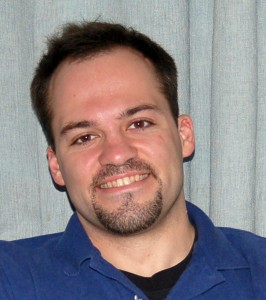Stanton Fernald | Medical Illustrator
Medical illustrator helps us see the art of science
 “Say, isn’t that a seminiferous tubule?” That’s what your friend the reproductive biology researcher might exclaim as the two of you stroll through a gallery installation by light sculptor Stan Fernald, who graduated from the Kansas City Art Institute in 1994. Fernald, who also works as a medical illustrator at a University of Kansas Medical Center research lab, combines the worlds of advanced scientific research and art in provocative installations that sometimes include vivid images of human cells and insects projected on gallery walls.
“Say, isn’t that a seminiferous tubule?” That’s what your friend the reproductive biology researcher might exclaim as the two of you stroll through a gallery installation by light sculptor Stan Fernald, who graduated from the Kansas City Art Institute in 1994. Fernald, who also works as a medical illustrator at a University of Kansas Medical Center research lab, combines the worlds of advanced scientific research and art in provocative installations that sometimes include vivid images of human cells and insects projected on gallery walls.
“I love showing people something that is usually only visible through a microscope,” said Fernald. He’s figured out how to use state-of-the-art optics to take a cellular structure that’s just a couple of microns wide and project it many thousands of times larger onto a wall, architectural surface or city street: the sertoli cell that ate Cleveland. He further incorporates physics and engineering into his work by elegantly mounting confocal microscopes and LED laser projection systems directly in front of the imagery. They become part of the gallery installation, thus inviting the viewer to consider the collaboration between science and art.
Collaboration also characterized Fernald’s education. He began undergraduate life as an engineering student at Oklahoma State University but found himself drawn to art classes as well. Art proved to be the stronger magnetic force, so he transferred to KCAI. It was the right move. Just as he finished his foundation coursework and began thinking about a major, Fernald experienced an “aha” moment. By majoring in industrial design, then offered at KCAI, he could combine his engineering background, artistic education and inventive nature.
In between coursework, Fernald found time to build a low-watt FM station and a TV station (both from kits) in his dorm room. He and other students broadcast music and student programming throughout the campus and neighborhood. The projects fizzled after a few months, however, when it became clear that being a media magnate was taking too much time away from classes and socializing.
After graduation, he took his fascination with light, new media and design to the next level while pursing a master’s degree at Domus Academy in Milan, Italy. Upon returning to the U.S., Fernald took some time off from art, but not creativity. He built cabinetry, mowed lawns and did computer tech support. In a machine shop located underneath his carriage-house apartment near KCAI, he built a pedal-powered car and experimented with projecting art on buildings.
Eventually, he fell into a full-time job that felt like the right combination of science and art. For the past eight years, he’s been a medical illustrator. “Medical illustration is a very niche field,” noted Fernald. “It requires excellent drawing skills and a talent for research. You have to be good at explaining through drawing.”
Medical illustrators typically hone their skills during a master’s degree program, but anyone with a B.F.A. in graphic design can become certified after five years of working in the field. (See the Association of Medical Illustrators (www.ami.org) for more information.)
In recent years, Fernald has begun to pursue public art projects. His work was featured at Kansas City’s Last Show Gallery for emerging local artists. The Greenlease Gallery at Rockhurst University displayed several of his projection art pieces. This fall, his intricate imagery is on display at Kaw Valley Arts and Humanities Gallery in Kansas City, Kan. (www.kvah.org)
Fernald credits the support he received from KCAI with giving him the confidence to pursue a life filled with science, creativity and experimentation.
“KCAI allowed me to reinvent myself,” said Fernald. “It gave me the ability to view myself as a project.”
[nggallery id=3]